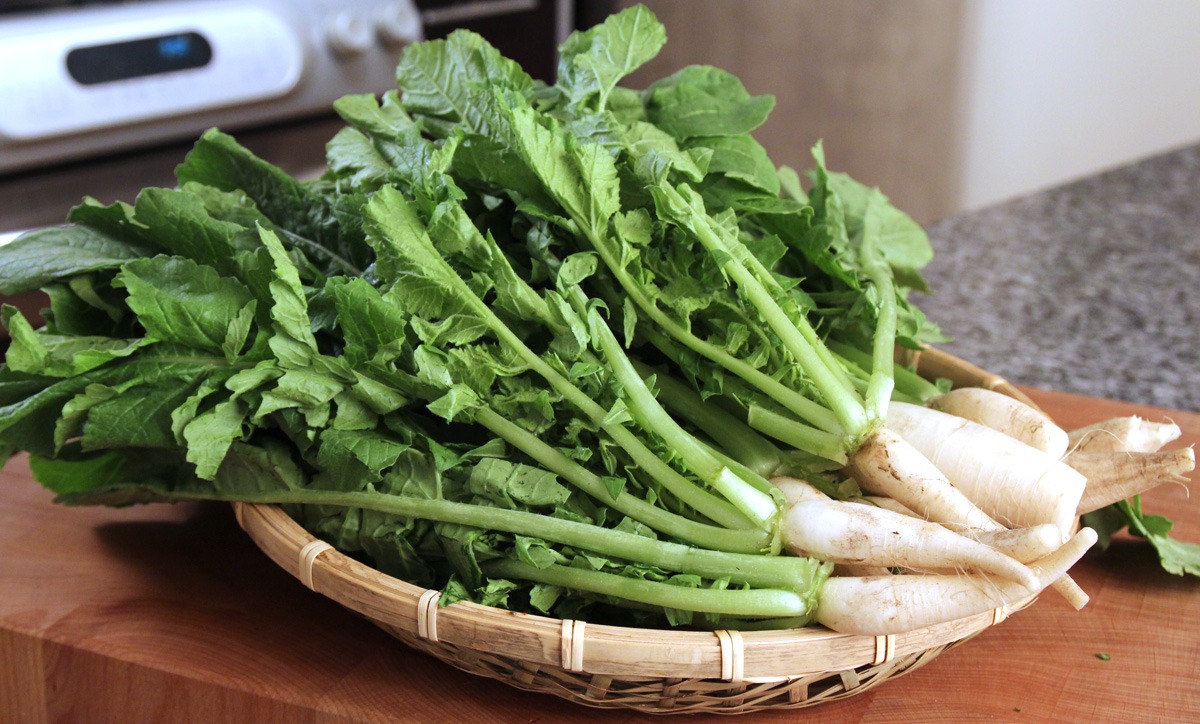Trash Talk: Radish Greens

Trash Talk is our new monthly column by Arina Suchde that focuses on in-season vegetables and provides recipes and inspiration for squeezing every ounce of deliciousness from your ingredients, root-to-shoot and seed-to-skin. We kick off the series with delicate, nutrititious, often-overlooked radish greens.
When we hear the term ‘food waste’, what first comes to mind is left-over cooked food. Most people don’t realise that the waste begins in the kitchen, long before the cooking process begins. Many parts of fruits and vegetables – the skin, peel, rind, seeds, core and stem – end up in the trash when they should be on our plates. But if we look back just a few generations, when luxury of waste was not an option, there was both knowledge and skill to efficiently put to good use, every inch of produce.
I use the word luxury because older generations didn’t have access to the infrastructure, logistics or economy that we do, let alone the abundant variety and volume of produce that is now available year round. Quite often, the bits that get thrown ino the trash have major health benefits, oftentimes more than the actual fruit or vegetable, itself; most people aren’t aware, or simply don’t have the time and inclination, to use produce to the fullest.
My journey of root-to-shoot and skin-to-seed cooking has been more personal than professional. I lost my grandparents very young, so I missed the chance to learn old recipes from them, or even cook with them. I missed inheriting a collection of family recipes passed down through generations, recipes that were part of my family’s history and roots. Growing up in a Gujarati family in Mumbai, I wasn’t exposed to traditional Gujarati food, nor did I take much interest in it, until a few years ago. But my training as a chef opened my mind up to rediscovering traditional Indian recipes, and cooking with new or forgotten ingredients. So I decided to document recipes from family and friends, and create my own collection of recipes, to then be shared with generations after me.
My mother taught me the value of a sustainable approach. She always stopped me when I discarded parts of ingredients, teaching me things along the way. The one recipe that I watched her make for decades, that fits perfectly with the philosophy of root-to-shoot, is a traditional and popular Gujarati farsan called moola na paan na muthiya, made with the entire radish, especially in winter and spring, when they come with the greens.
Radish greens or mooli ke patte are a nutritional powerhouse – I don’t know how they haven’t been classified as a superfood yet, or caught on as the next big global fad, like kale, quinoa, moringa and turmeric have. The most obviously great thing about them is that they are green – and we can all agree on the importance of greens in our diet. Radish greens (tender stems included), provide much-needed dietary fibre for the smooth functioning of the digestive system. The leaves are loaded with iron, vitamin C, vitamin A, folic acid, potassium and other unique antioxidants – and interestingly, the roots have almost none. These nutrients make the greens a natural diuretic, helping with kidney and bladder-related issues, contribute to stronger immunity, fight anaemia and fatigue, and protect against diabetes, scurvy, rheumatism and jaundice. It is unforgiveable then, that these greens are most often trashed before the radish even reach the markets.
Moola na paan na Muthiya
The word muthiya is derived from the Gujarati word mutthi meaning fist, as these little dumplings are shaped by clutching the dough in the palm of your hand, to form an oval, cylindrical dumpling.
Ingredients
For the dough
1 small/ half large radish, scrubbed well and grated with skin
1 cup finely chopped radish greens including stems
¼ cup bajra (pearl millet) flour
¼ cup jowar (sorghum) flour
3 tbsp whole wheat flour
3 tbsp besan (gram flour)
1 tsp ajwain (carom) seeds
1 tsp dhania (coriander) powder
1 tsp jeera (cumin) powder
½ tsp ginger paste
½ tsp green chili paste
¼ tsp haldi (turmeric) powder
1 tsp lime juice
Salt to taste
Water, if required
Oil as required for greasing
For the Tempering
2 tsp oil
1 tsp cumin (jeera) seeds
1 tsp rai (mustard seeds)
1 tsp til (white sesame) seeds
A pinch of hing ( aesofatida)
Chopped coriander leaves for garnish
Method
Prepare a steamer and let the water boil while preparing the dough. Grease the perforated tray/flat colander and keep ready.
Mix all the ingredients for the dough (except oil) in a bowl and mix gently to form a soft dough without kneading too much.
If the moisture from the grated radish and greens is not enough to bind the dough, add water one tablespoon at a time making sure the dough is not too wet and sticky.
Form small oval dumplings using your fist; grease your palm with oil if the dough is sticky.
Steam the dumplings for approximately 15-20 minutes on medium heat.
They should be done if the knife/skewer comes out clean when inserted in the centre.
Let the dumplings cool completely and then cut them into ¼ inch slices.
Heat oil in a wok and add the jeera, til, rai and hing. Once the seeds crackle add the sliced Muthiya and toss well. Continue tossing till the slices firm up and get crisp and golden around the edges.
Garnish with chopped coriander leaves. Serve with a spicy coriander chutney and piping hot chai.
Arina Suchde is a chef and mixologist specialising in health-focussed culinary workshop for kids and adults.
YOU MAY ALSO LIKE









